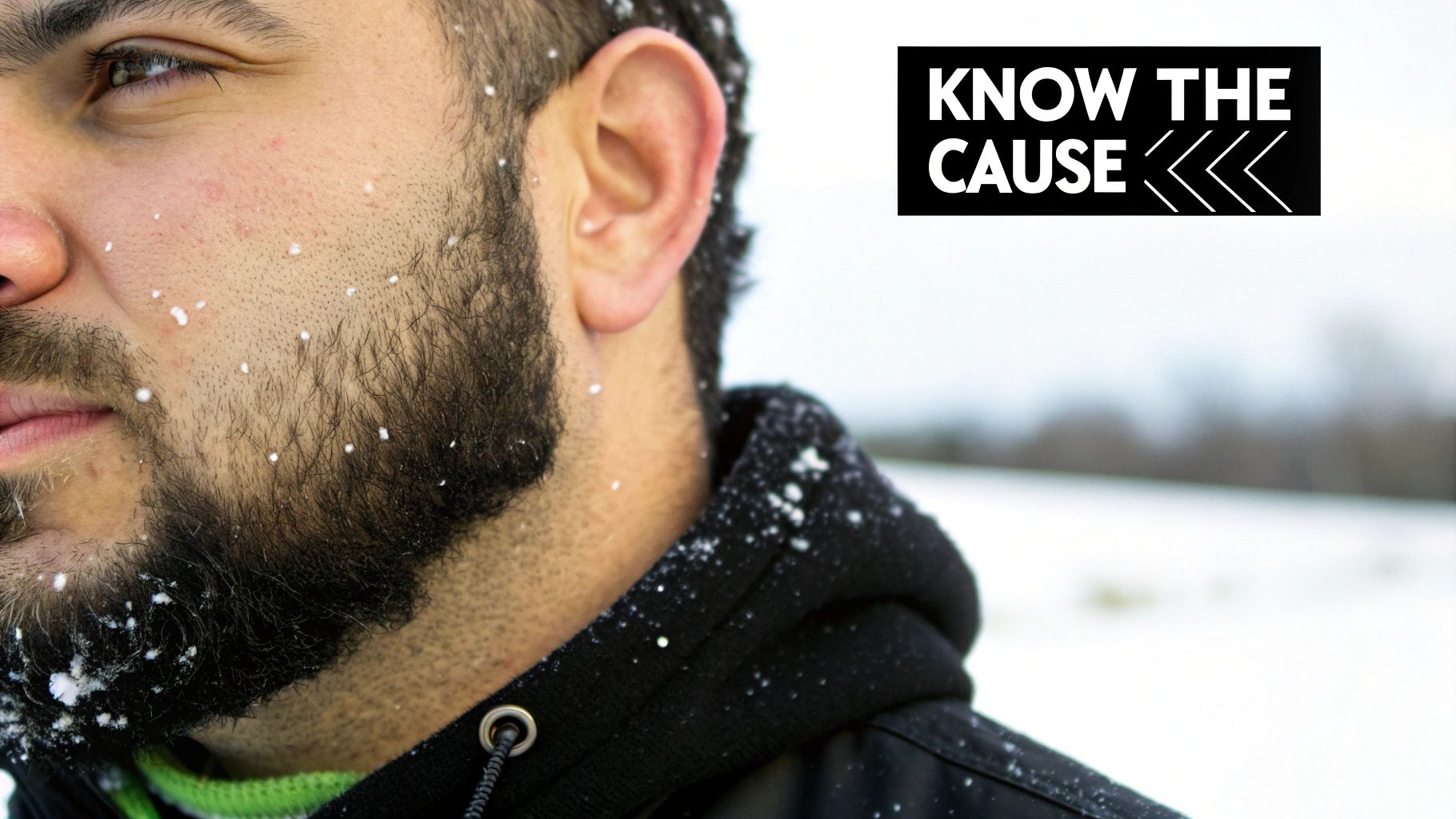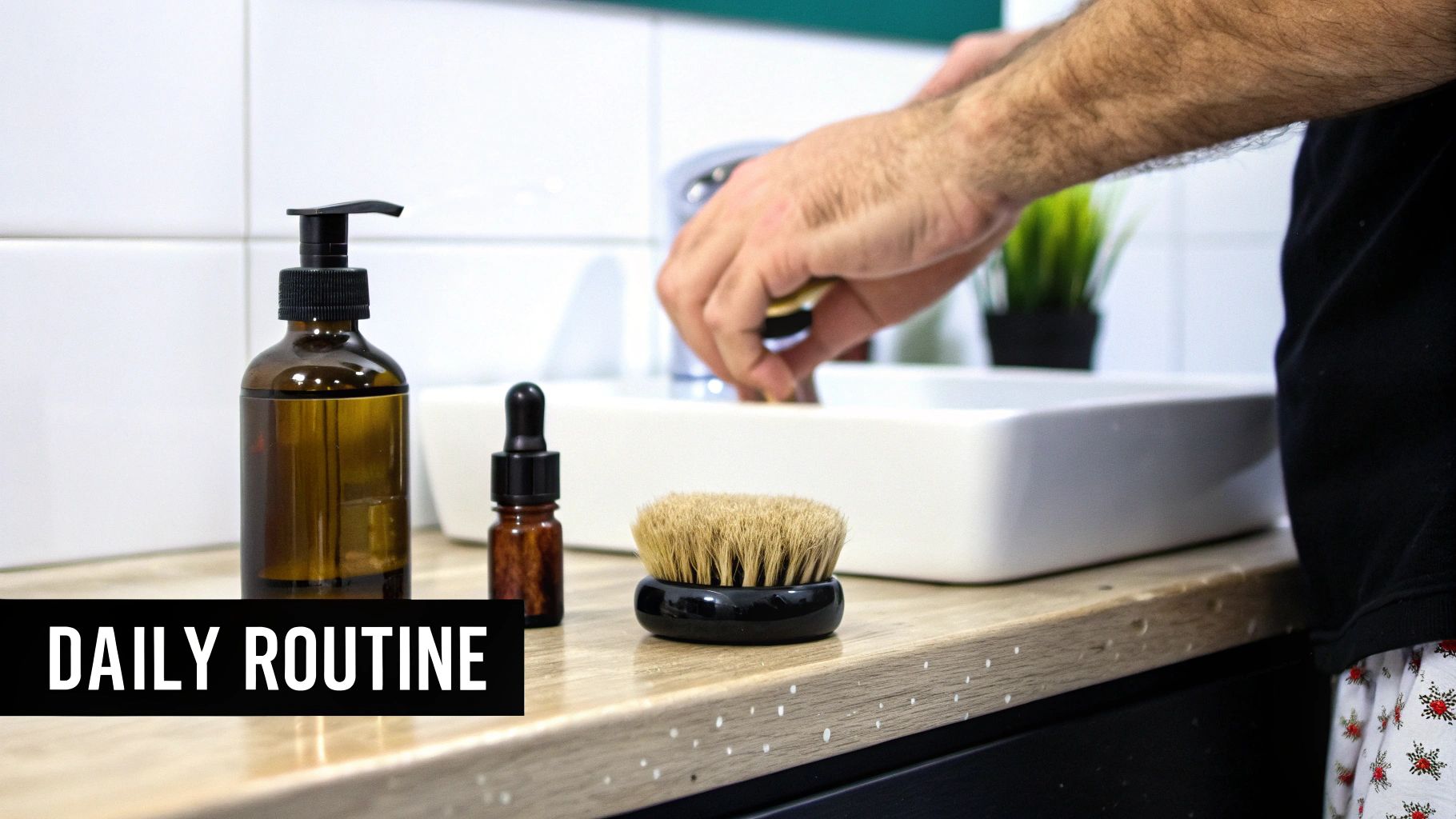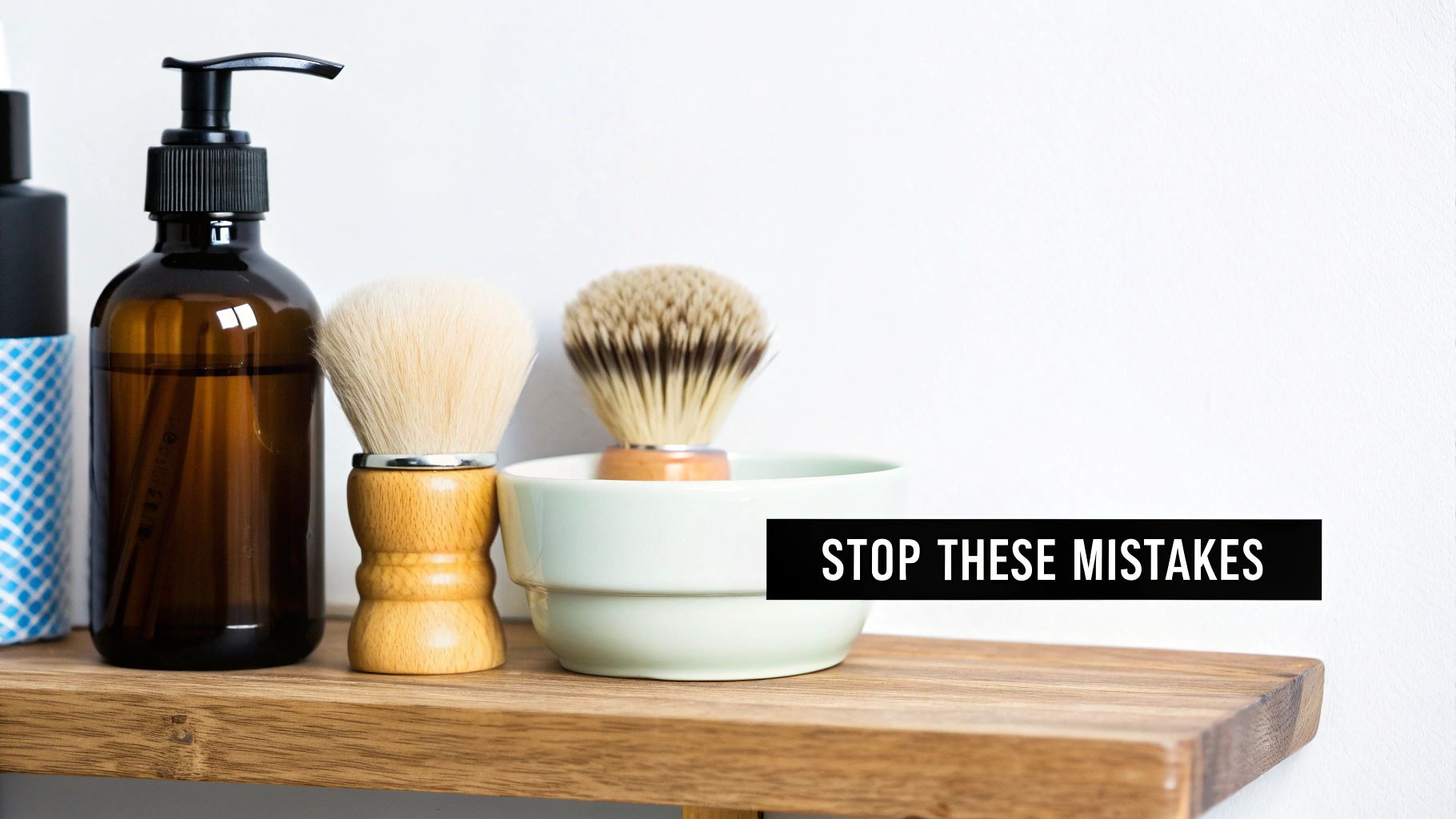Jan Elvis
06.11.2025

Jan Elvis
06.11.2025
You've grown a solid beard, but now you're dealing with an unwelcome guest: those annoying white flakes. This isn't just a simple case of dry skin. More often than not, it’s a mild form of seborrheic dermatitis.
At its core, this common skin issue is caused by an overgrowth of a yeast that naturally lives on your skin, called Malassezia. When it gets out of hand, it triggers irritation and, you guessed it, a flurry of white flakes.

Think of the skin under your beard as its own little world. When things are running smoothly, your skin is happy and hydrated. But a few key things can throw that balance off, paving the way for beard dandruff.
The main offender is a fungus named Malassezia globosa. It loves to snack on the natural oils (sebum) your skin produces. As it digests these oils, it leaves behind oleic acid. For about half the population, this acid is a major irritant, causing the skin to get inflamed and speed up its cell turnover.
That rapid shedding of skin cells is what creates the flakes you see tangled in your beard. It’s the exact same thing that happens with dandruff on your scalp, just on your face instead.
While the yeast is the root cause, a few everyday habits can really pour fuel on the fire. These triggers either strip away your skin's natural defenses or create a five-star environment for that yeast to multiply.
Keep an eye out for these common culprits:
If you're struggling with this, know you're in good company. Seborrheic dermatitis, the leading cause of beard dandruff, affects 1–3% of adults globally, and men tend to get it slightly more often.
Figuring out what your skin needs is half the battle. If you're not sure where to start, check out our guide on how you can tell your skin type. It'll give you the roadmap to building a routine that actually works.

If you're tired of the constant itch and embarrassing "beard snow" on your shirt, listen up. Fixing the dry, flaky skin under your beard isn't about some miracle product or aggressive scrubbing. It all comes down to building a simple, consistent daily routine.
Think of it this way: each step builds on the last, creating a powerful defense that keeps your skin hydrated and your beard looking sharp. This is what separates a healthy, comfortable beard from a perpetually itchy one.
First things first: step away from your regular body wash or hair shampoo. I see this mistake all the time. Those soaps are designed to strip heavy oils from your scalp and body, which is way too harsh for the sensitive skin on your face. Using them on your beard is a one-way ticket to making the flake situation a whole lot worse.
Your move? Grab a dedicated beard wash and use it a few times a week. These are formulated to be gentle, cleaning the hair and the skin underneath without causing that tight, dry feeling. Always use lukewarm water—hot water is another moisture-stripper—and gently massage the cleanser right down to the skin. You're aiming to clear away buildup, not disrupt your skin's natural balance.
Once your beard is clean, you have to lock in moisture immediately. This is where beard oils and balms become your absolute best friends. A standard face lotion just can't penetrate a thick beard to reach the skin that’s desperate for hydration.
Look for products with natural, non-comedogenic oils like jojoba or argan oil. These are fantastic because they closely mimic your skin's own sebum, so they moisturize deeply without clogging your pores and causing breakouts. A few drops of beard oil worked all the way to the skin every single morning can be a total game-changer.
If your skin is exceptionally dry, you might need a bit more firepower. Our guide to the best facial moisturizers for dry skin has some great recommendations that can work alongside your beard care products.
To help you stay on track, here's a simple blueprint for your daily routine. Consistency is everything, so try to stick to this as closely as you can.
| Action | Purpose | Pro-Tip |
|---|---|---|
| Cleanse Gently | Remove dirt, oil, and dead skin without stripping natural moisture. | Use a dedicated beard wash 2-3 times per week with lukewarm water. |
| Hydrate Daily | Moisturize the skin under the beard to prevent dryness and flakes. | Apply beard oil or balm every morning, massaging it down to the skin. |
| Brush Regularly | Distribute oils evenly and gently exfoliate the skin. | Use a soft-bristle beard brush once a day to keep skin healthy. |
Following these steps will create a solid foundation, turning your routine from a chore into a powerful tool for a flake-free, comfortable beard.
Finally, don't underestimate your tools. A good beard brush is for more than just styling; it's a critical part of keeping the skin underneath healthy. A soft-bristle beard brush should be a non-negotiable part of your kit.
Here's why daily brushing is so important:
This simple act elevates a basic grooming step into a proactive treatment for dry flaky skin under your beard. It’s the finishing touch that keeps your skin breathing easy and your beard looking incredible.

When your daily routine just isn't cutting it and the flakes persist, it's time to bring in the big guns. If you’ve been on top of your washing and moisturizing game but still find yourself brushing snow off your shirt, you’re likely dealing with a more serious buildup of dead skin or an overgrowth of the Malassezia yeast.
These next steps are your secret weapons, not your everyday go-to's. Think of them as a weekly reset button for the skin under your beard. Overdo it, and you risk causing more irritation. But deployed strategically once or twice a week, they can knock out even the most persistent dry flaky skin under your beard.
If a good beard brush isn't enough to clear the way, a chemical exfoliant can be a game-changer. I’ve found products with salicylic acid to be incredibly effective here. Unlike a harsh physical scrub, salicylic acid is an oil-soluble beta-hydroxy acid (BHA), which means it gets right into your pores and hair follicles to break down the gunk holding dead skin cells together.
This process clears away the buildup without needing to scrub your face raw—a huge plus for skin that’s already inflamed.
When you start using a salicylic acid treatment, remember a few key things:
For a lot of guys, the real culprit behind the flakes is seborrheic dermatitis. This is where you need to get the yeast population under control, and that's exactly what medicated anti-dandruff shampoos are for. Look for powerhouse active ingredients like ketoconazole or selenium sulfide.
Don't just replace your beard wash with a medicated shampoo. That's a rookie mistake that will dry you out. Instead, use it as a targeted treatment 1-2 times a week. Lather it up, really work it into the skin, and let it sit for a few minutes to do its job before rinsing thoroughly.
On days when you aren't using a medicated shampoo, you can bring in some heavy-duty moisture to counteract any potential dryness. Things like hot oil treatments work wonders for deeply conditioning both the skin and the beard hair. It’s this combination of targeted treatments and consistent care that will finally put an end to the flake show.

Sometimes, the real cause of that stubborn dry flaky skin under your beard isn't some complex issue. It often comes down to a few common grooming habits that are quietly sabotaging your efforts. You could have the best products in the world, but one or two of these missteps can undo all your hard work.
Let’s start in the shower. One of the biggest culprits is cranking the heat way up. A scalding hot shower might feel amazing, but it’s brutal on your skin. That hot water strips away the natural, protective oils, leaving the sensitive skin under your beard defenseless, dehydrated, and ripe for irritation.
And what are you washing it with? If you're just grabbing your regular hair shampoo or body wash, you're making another classic mistake. Those products contain harsh detergents meant to tackle oil on your scalp or body—they're way too aggressive for your face.
What you do after the shower is just as critical. I see this all the time: guys aggressively rubbing their beards dry with a rough towel. That’s like taking sandpaper to already sensitive skin. All that friction creates tiny abrasions and kicks up inflammation, which is a direct flight to more flakes.
The fix is simple. Gently pat your beard and the skin underneath with a soft towel. Your goal is just to absorb the excess water, not to scrub it bone-dry. This one tiny change can make a huge difference by cutting down on physical irritation.
The most common mistake? Inconsistency. Slapping on some beard oil whenever you happen to remember isn't going to solve the problem. Your skin craves routine. Skipping your daily moisturizer is basically rolling out the welcome mat for dryness and flakes to return.
Making a few small adjustments can have a massive impact. Here’s a quick rundown of what to swap out:
| Stop Doing This | Start Doing This |
|---|---|
| Taking scalding hot showers | Using lukewarm water on your face |
| Using regular hair shampoo | Washing with a dedicated beard wash |
| Rubbing beard dry with a towel | Gently patting your beard dry |
| Moisturizing inconsistently | Applying beard oil or balm daily |
Good grooming also means clearing out the gunk that causes flakes in the first place. If you're not sure about the best approach, our guide on how to exfoliate your face properly has some great techniques you can easily adapt for the skin under your beard. Nailing these fundamentals is what makes everything else you do actually work.
So, you've tried everything. You're washing, conditioning, and oiling your beard with religious dedication, but the flaking and itching just won't quit. At this point, it's worth considering that you might be dealing with something more than a simple case of dry skin.
https://www.youtube.com/embed/J7IZ2HsVpYY
Most beardruff is just that—a bit of dry skin or mild seborrheic dermatitis. But if your symptoms feel more severe, you need to pay attention.
We’re talking about red flags like:
These aren't the signs of everyday dryness. They're your skin's way of telling you something more serious is going on underneath the scruff.
The goal isn't to play doctor and self-diagnose from a web article. It’s about knowing when to call in a professional. If you’ve given it a few weeks with over-the-counter stuff and things are getting worse, not better, it’s time to book an appointment with a dermatologist.
One possibility, though it’s not super common, is a fungal infection called tinea barbae. It can look a lot like a nasty case of beardruff but won't respond to the usual treatments. Back in the 19th century, it was often called "barber's rash" because it was frequently spread by unsterilized razors. You can actually read up on this fungal infection's impact on beard health for some interesting historical context.
When your best efforts aren't cutting it, a dermatologist can figure out exactly what’s happening and get you the right treatment to solve the problem for good.
Alright, let's get into some of the most common questions guys have when they're staring down at a shirt dusted with beard flakes. Getting these answers straight is half the battle.
Look, everyone wants a quick fix, but this is about healing your skin. If you jump on a consistent routine—we're talking gentle washing, daily beard oil application, and consistent brushing—you should honestly feel and see a difference in about one to two weeks. The first thing you'll notice is less irritation and itchiness as your skin starts to get the hydration it's been screaming for.
Now, if you're dealing with a really stubborn case, maybe something like seborrheic dermatitis, it might take a bit longer to get things fully under control. The absolute key here is consistency. Don't just do it for a few days and give up; your skin needs that steady care to truly heal and stay flake-free.
Absolutely. It's easy to forget, but your skin is an organ, and what you eat directly impacts its health. If your diet is heavy on sugar and greasy junk food, you're basically feeding inflammation, which can make any skin problem worse.
On the flip side, you can eat your way to healthier skin. Think of it as building your defenses from the inside out. Try to work in more of these:
A better diet won't make beardruff vanish overnight, but it creates the best possible environment for your skin to thrive. It makes every other step in your grooming routine that much more effective.
I get the temptation—it's right there on the counter. And while it's better than using nothing at all, your standard face moisturizer just isn't built for the job. Most lotions are too thick to navigate through a dense thicket of beard hair. They end up sitting on the hair itself instead of reaching the skin underneath where the problem is.
This is exactly why beard oils were invented. They are made with carrier oils like jojoba and argan, which are much lighter and have a molecular structure that allows them to seep right down to the follicle and moisturize the skin directly. They deliver the goods where you actually need them.
Ready to build a routine that finally puts an end to the flake show? The Main Character collection has all the tools you need to get the skin under your beard healthy, hydrated, and comfortable. Explore our grooming solutions and reclaim your confidence.